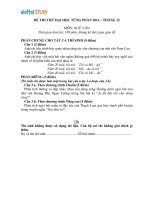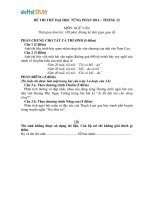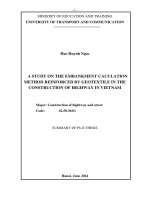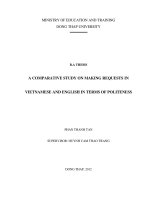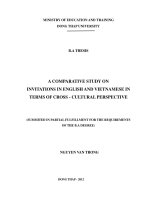12 abalone reproduction study lleonartmark 1993 thesis
Bạn đang xem bản rút gọn của tài liệu. Xem và tải ngay bản đầy đủ của tài liệu tại đây (12.54 MB, 199 trang )
A GONAD CONDITIONING STUDY OF THE GREENLIP ABALONE
(HALIOTIS LAEVIGATA).
MARK LLEONART
Thesis presented for award of Masters Degree by Research.
University of Tasmania, 1992.
Declaration:
I hereby declare that this thesis has been composed by myself, that it has not
been accepted in any previous application for a degree, that the work of which
this is a record has been done by myself, that all quotations have been
distinguished by quotation marks and the sources of information have been
specifically acknowledged.
t
L471,09"---A
M. Lleonart.
CONTENTS
1. INTRODUCTION
1
2.MATERIALS AND METHODS
2.1 Experimental Animals
6
2.2 Holding Conditions
8
2.3 Experimental Design
13
2.4 Length of Reproductive Cycle
15
2.5 Measurement of Growth
16
2.6 Measurement of Seaweed Consumption 18
2.7 Seaweed Preference
19
2.8 Structure of the Gonad
20
2.9 Sample Preservation and Histological Preparation 22
2.10 Gonad Indices
23
2.11 Measurement of the GBI
24
2.12 Measurement of the MGBI
25
28
2.13 Gonad as Percentage Body Weight
29
2.14 Subjective Gonad Indices
2.15 Measurement of Oocyte Size/Frequency Distribution 29
2.16 Measurement of Mean Oocyte Diameter 33
2.17 The Ovarian Phase Method
34
2.18 Quantification of Testis Maturation 35
2.19 Comparison of Gonad Development Methods 36
2.20 Comparison with the Reproductive Cycle of
the Source Population
38
38
2.21 Methods for Fecundity Estimation
2.22 Estimation of Number of Spawned Eggs40
2.23 Fecundity Estimation by Known Weight
41
Subsample Method
2.24 Fecundity Estimation by Known Volume
42
Subsample Method
43
2.25 Induction of Spawning
46
2.26 Sex Ratio
47
2.27 Statistical Methods
3.RESULTS
49
3.1 Conditioning Time
52
3.2 Growth
3.3 Feed Consumption and Seaweed Preference 55
57
3.4 GBI Data
60
3.5 MGBI Data
63
3.6 Gonad as Percentage Body Weight
3.7 Visual Assessment of the Developing Gonad 64
3.8 Oocyte Size/Frequency Distribution Data 65
3.9 Mean Oocyte Diameter Data
70
72
3.10 Ovarian Phase Data
76
3.11 Testis Maturation Data
3.12 Descriptive Histology of the Ovary 78
3.13 Descriptive Histology of the Testis 85
89
3.14 The Reproductive Cycle of the
Source Population
92
3.15 Fecundity Data
3.16 Correlations between Fecundity and 96
Gonad Indices
3.RESULTS Continued....
3.17 Sex Ratio Data
97
4. DISCUSSION
4.1 Comparison of Conditioning Tank Results
4.2 Comparison of Conditioning Tank Design
4.3 Comparison of Feed Consumption and
Feed Preference Data
4.4 Comparison and Evaluation of the GBI Data
4.5 Comparison and Evaluation of the MGBI Data
4.6 Comparison of Gonad as Percentage Body Weight Data
4.7 Comparison of Subjective Gonad Indices
4.8 Comparison and Evaluation of Oocyte Size/
Frequency Distribution Data
4.9 Comparison of Mean Oocyte Diameter Data
4.10 Comparison of Ovarian Maturity Phase Data
4.11 Comparison and Evaluation of Testis
Maturation Data
4.12 Comparison of Ovarian Histology
4.13 Comparison of Testicular Histology
4.14 Comparison and Evaluation of Gonad Measures
4.15 Discussion of Fecundity Data
4.16 Abalone Spawning Seasons
4.17 Comparison of Sex Ratio Data
4.18 The Importance of Exogenous Factors in Relation
to Gonad Conditioning of Abalone
98
102
106
109
113
115
116
118
120
122
_125
128
130
131
133
138
139
141
5.SUMMARY AND CONCLUSIONS
146
6. ACKNOWLEDGMENTS
147
7.REFERENCES
148
8.APPENDICES A-J
ABSTRACT
The Australian greenlip abalone Haliotis laeviqata is of
commercial importance in the abalone diving industry. The
species is also believed to have culture potential and
accordingly control over reproduction is considered valuable.
The major purpose of the study was to accelerate gonad
development resulting in spawning outside the natural spawning
season.
Abalone were collected from Franklin sound in the Furneaux
group of islands off the north-east tip of Tasmania. The
important features of the conditioning tank were elevated
water temperature, the provision of water movement within the
tank to distribute feed to sedentary abalone and a diet of
preferred red algae.
Animals collected on 27 April 1990 were induced to spawn on
21 August 1990, 112 days or 1750 degree days following
commencement of gonad conditioning. The natural spawning
season of the source population was found to be November to
March.
A variety of methods for measuring reproductive development
of abalone were used. This allowed the utility of individual
methods to be examined and comparisons made between methods.
Two gonad indices, the gonad bulk index (GBI) and the modified
gonad bulk index (MGBI) were used as were a number of
assessment methods with a histological component: oocyte
size/frequency distribution, mean oocyte diameter, an ovarian
phase method and percentage mature spermatozoa. The MGBI was
considered more sensitive than the GBI, detecting first
significant gonad growth following six weeks of gonad
conditioning, compared to nine weeks for the GBI.
The gonad indices increased from initial values of 14.1 ±
4.4, n=10 and 0.4 ± 0.2, n=10 for GBI and MGBI respectively to
72.3 ± 9.2, n=10 and 7.0 ± 2.0, n=10 following 105 days of
gonad conditioning. Mean oocyte diameter (Am) increased from
30.7 ± 2.0, n=5 initially to 109.7 ± 6.0, n=5 during the same
time period. The percentage of male germ cells present as
mature spermatozoa increased from zero to 90.6 ± 16.3, n=5
following 24 weeks of conditioning.
1. INTRODUCTION
Abalone are herbivorous marine gastropods of commercial
importance. There are approximately one hundred species worldwide, all of which belong to the single genus
Haliotis.
Abalone are valued primarily for the meat of the large,
powerful foot muscle. Twenty-two species of commercial
importance are described by Hahn (1989). The majority of these
species attain- relatively large sizes and occur in temperate
waters.
The major abalone fishing countries are Australia, Japan,
Mexico, South Africaandthe United States.Certain
characteristics of abalones make them susceptible to
overfishing, which has occurred to varying degrees in all
abalone producing countries. These characteristics include the
predictability of location and accessability of abalone
populations and the lack of mobility shown by adults. In
addition, growth to adult size is slow and recruitment is
unpredictable (Tegner and Butler, 1989). Declining yields from
the traditional fishery source have led to interest in abalone
culture for reseeding programs and in captive growout to so
called 'cocktail size' of between 5 cm and 8 cm.
The Japanese pioneered the use of hatchery reared juveniles
to enhance wild stocks (Tegner and Butler,1989). This strategy
appears successful and according to Hahn (1989) the domestic
harvest is relatively stable although the demand is still
high. In California a sharp decline in the abalone catch
served as an impetus. for . fishery enhancement through
aquaculture (Ebert and Houk, 1989). Unlike in Japan, the
1
emphasis in California has been on captive growout rather than
reseeding. In .Taiwan according to Chen (1989) increased demand
and soaring prices led to the development of a successful
culture industry.
Commercial culture of abalones is practiced in Japan,
Korea, Taiwan, The United States, and has commenced in
Australia and New Zealand. Haliotis discus Reeve and H.discus
hannai Ino are produced in Japan and Korea; H.diversicolor
Reeve is farmed in Taiwan, and H.rufescens Swainson and
H.fulciens Philippi are cultured in the United States. The
successful culture industry in Taiwan produced approximately
500 tonnes of abalone in 1986 (Chen, 1990).
There are three haliotid species of commercial importance
in Australia: H.laeviclata Donovan, H.rubra Leach, and the
smaller H.roei Gray. The first two species are commonly called
greenlip and blacklip abalone respectively. The export value
of Australian abalone was 91.3 million dollars in the 1989/90
financial year (Australian Bureau of Statistics). Over three
thousand tonnes of abalone were exported in live, chilled,
frozen and canned forms to Hong Kong, Japan, and Singapore.
Tasmaniaisthelargestabaloneproducing state
contributing 46% of total tonnage. Management measures
introduced to protect the fishery in this state resulted in
quotas for professional diver's reduced from 30.8 t in 1985 to
16.8 t in 1989. Such reductions in yield locally coupled with
the known history of abalone fisheries overseas have
contributed to interest in culturing local species. To date,
research and farming effort have focused on H.laevigata and
2
H.rubra.Both abalones are believed to have relatively high
growth rates (Shepherd and Hearn, 1983), especially the former
species (Hone, 1989).
Control of the reproductive cycle is generally desirable
for aquaculture. Induced maturation of captive abalone is
referred to as conditioning or gonad conditioning and is
generally practised where haliotids are cultured. The
quantification of conditions required to produce gonad
maturation of abalone e.g. time, temperature, diet and tank
design have been established for the Japanese species H.discus
(Kikuchi and Uki, 1974), H.cliciantea Gmelin (Kikuchi and Uki,
1975) and H.discus hannai (Uki and Kikuchi, 1984).Control over
the reproduction of the following North American species has
also been achieved: H.fulgens (Leighton et al., 1981),
H.rufescens (Ebert and Houk, 1984; Ault, 1985), H.corructata
Wood (Morse,1984) and H.cracherodii Leach (Morse, 1984).
However full quantification of the conditions required for
gonad conditioning of these species has generally not been
reported.
The major advantage of gonad conditioning is the
flexibility that can be introduced to production cycles. This
is of particular advantage where culture species have
restricted natural spawning seasons. The majority of haliotid
species examined do in fact have an annual spawning season,
typically of three or four months duration (section 4.16).
Therefore, gonad conditioning may allow for more efficient use
of hatchery resources through year round production.
Additionally, production cycles can be initiated to take
advantage of seasonal temperature variations. For example,
3
where species naturally spawn in late summer it may be
advantageous to induce maturation several months early. This
exploits the seasonal spring/summer rise in sea temperature,
extending the time period post larvae are initially exposed to
warm water and thus maximizing early growth.
A further advantage of gonad conditioning is that
conditioned abalone produce more eggs than wild abalone of
equivalent size (Ault, 1985). This allows relatively small
abalone to be kept as broodstock reducing the quantity of
hatchery resources such as feed and tank space allocated to
such animals. Additionally, control over the reproductive
cycle of abalones makes possible selective breeding programs
to identify desirable traits such as superior growth rates.
Hybridization of species which may be advantageous in terms of
appearance and growth rate is also simplified by conditioning
abalones. Indeed, where pairs of haliotid species do not share
a spawning season hybridization cannot be achieved without
gonad conditioning.
The major purpose of this study was to produce out of
season spawning of the greenlip abalone H.laevigata through
gonad conditioning. The spawning season of the species is the
summer months in South Australia (Shepherd and Laws, 1974) and
Victoria (McShane, 1988). Observation suggests this is also
the case in Tasmania and a population of H.laevigata was
monitored to provide confirmation. Therefore, it was planned
to induce spawning in winter to demonstrate the effectiveness
of the conditioning process. By this means the length of the
reproductive cycle and feed requirements would be quantified.
A further aim of the research was to compare the usefulness
of a variety of measures that have been used to monitor
reproduction in abalone. In particular, two commonly used
gonad indices were compared as were four methods involving a
histological component. An examination of gonad maturity
measures was considered important since a conditioning study
by Ault (1985) showed the commonly used gonad bulk index to be
incapable of detecting gonad maturation. Additional purposes
of the research were to measure fecundity and determine
seaweed preferences of H.laevigata.
5
2. MATERIALS AND METHODS
2.1
Experimental Animals
Specimens of H.laevictata (mean weight 359.9 g, s.d.=83.4 g;
mean length 140 mm, s.d.=10 mm; n=128) were selected from a
professional divers catch on 27 April 1990. The animals from
Franklin Sound (Figure 1) were captured on a limestone reef at
a depth of about five metres. Water temperature at the time
was approximately 16°C. Franklin Sound is a stretch of
.
water
in the Furneaux Islands group located in eastern Bass Strait.
The Furneaux group is a major contributor of H.laevigata to
the Tasmanian fishery for the species (21% in 1987, Department
of Primary Industry statistics).
The experimental animals were selected on the basis that
they displayed no apparent sign of injury as a result of
capture and that the first and second respiratory holes were
free of obstruction to permit tagging. The legal minimum size
for abalone in Tasmania is 132 mm and the pool of animals
available for selection ranged from this size to approximately
180 mm. Because the feed requirements of abalone increase with
size larger individuals were rejected. Every effort was made
to select animals of the same size.
The reproductive cycle of the population from which the
animals were selected had not been previously documented.
Anecdotal evidence from local abalone divers suggests ripe
individuals are found from November to at least January.
6
FIGURE 1
Collection Sites for Abalone and Seaweed
cfo*
Frank lin Sound
Bicheno
AUSTRALIA
7
At the time of capture gonad development was minimal and the
sex of individuals could not be distinguished.
The abalone were transported in expanded polystyrene fish
boxes packed with damp seaweed. Transport by air and road to
Abalone Hatcheries Pty Ltd (Bicheno, Tasmania) where the
research was conducted took five hours. No mortalities
occurred during transport or immediately thereafter. The
animals were allowed four days acclimatisation at ambient
temperature (16°C) and natural photoperiod (10 hr 40 min
light).
2.2
Holding Conditions
2.2.1
Abalone Hatcheries Pty.Ltd.
This aquaculture facility is located at Bicheno on the east
coast of Tasmania (Figure 1). The site is south of the natural
distribution of H.laevigata.
The experimental animals were housed in a 3000 1 fibreglass
tank with a central drain. The tank was fitted with four
easily removed mesh baskets, within which the abalone were
located. The mesh base of each basket was left uncovered to
allow fragments of uneaten food and faeces to fall through to
the tank bottom approximately 10 cm below. Plastic sheet was
fixed to the mesh on the sides of baskets to provide a
suitable substrate for abalone (Figure 2).
8
FIGURE 2
Conditioning Tank Design
I-1
INLET PIPE P
3
11
1
WATER LEVEL
13.
It
Ins
MESH BASKET
41111
1111
6111
4111
11
411
1
01...••••112...:74::•, k
.4o•-•
AERATION LINE
Ilk
aammou.
....ow.,
.............
1
a
V
DRAIN SCREEN
.111111111.11ONIMIlls
'‘... NM
1110.01101~11MIMIIKW■MIMNIMWIIIMWELWEIL111.
A.Side view
INLET PIPE
B.Overhead view
MESH BASKETS
9
Water entering the conditioning tank was directed into the
individual baskets through PVC pipe located below the water
surface. The purpose of this was to create water movement
within the baskets. Aeration was supplied to each basket by 13
mm polythene tubing threaded through the mesh of the base. A
major purpose of the aeration was to keep seaweed fed to
abalone in good condition and to circulate the weed affording
all animals feeding opportunities. The importance placed on
producing water movement in the conditioning tank was in part
due to the observation of Shepherd (1973) that water movement
elicits a characteristic feeding response in H.laevictata.
The conditioning tank was a flow through system with an
approximate exchange rate of 700 1/h. This flow rate was
considered adequate for removal of excretory products
providing suitable conditions for gonad development. The flow
was based on data cited in Hahn (1989) relating to H.discus
hannai.. Water entering the tank was sand filtered to 50 pm.
It was intended to maintain water temperature in the tank
at 17°C. In the absence of data relating to temperature
tolerance of H.laevigata, this figure was chosen as a
conservative maximum based on typical summer water
temperatures in the animal's natural range. In practice, as
winter approached this temperature could not be reached
without reducing water flow to undesirable levels. Heating was
achieved by the use of one or more 2 kw heaters placed
directly in the tank.
Light was excluded from the part of the hatchery containing
the conditioning tank by the use of shadecloth. An artificial
10
photoperiod of 14 hr light: 10 hr dark was provided by a timer
and 40 W light bulb suspended a metre above the water surface.
The purpose of this was to simulate day length during the
natural summer spawning season. This practice is in accordance
with commercial conditioning techniques used in Japan
(Hahn,1989). The light intensity at the water surface was 350
lux.
Experimental animals were fed a diet of fresh and/or frozen
algae. Abalone used in the experiment showed a strong
preference for red seaweeds which were supplied when ever
possible. The majority of the algae were obtained by shallow
water diving at Prosser Bay Orford, on the east coast of
Tasmania (Figure 1). The major species obtained from this site
were Hypnea sp., Rhabdonia coccinea Harvey, and Codium sp. (a
green seaweed which proved palatable). Two further red
seaweeds : Laurencia filiformis and Chiracanthea arborea
Harvey were obtained from Flinders Island. Smaller amounts of
the green seaweed Ulva sp. were fed as was the locally
abundant brown seaweed Macrocystis pyrifera Linnaeus. Live
algae were stored in 1000 I round, painted metal tanks located
outside the hatchery building. The tanks were aerated and
received approximately 100 l/h of unfiltered seawater. The
maximum amount of algae present in a tank at one time was
approximately 30 kg. In addition to the live food, a store of
R.coccinea was frozen and found to be still palatable after
four months. Each basket of abalone was generally given three
days supply of food at a time. The animals were fed to slight
excess and uneaten seaweed discarded if putrid. The algae
remained in good condition for weeks at a time in the storage
and experimental tanks with the exception of Hypnea sp.
11
The conditioning tank was cleaned twice weekly by siphoning
the waste feed and faeces from the tank bottom. Seaweed of
unpalat6'..,ie appearance also was removed from the baskets at
this time. Green. turban shells,
Subninella undulata Solander
were kept in the conditioning tank to consume small pieces of
feed descending from the baskets above.
A maximum/minimum thermometer was kept in the tank and the
temperature range recorded at least every three days. Nitrite
was measured with an Aquarium Systems Seatest kit and ammonia
tested with a Sera products test kit. These analyses were
performed four times while the abalone were housed in the
conditioning system described above.
2.2.2
University of Tasmania, Launceston Campus
Those abalone that had not been sacrificed for gonad
analysis were relocated to a tank at the University on 23
August 1990 following successful induced spawning. This tank
was a recirculating system with a 1000 1 holding section and a
600 1 detached biofilter box including approximately 250 1 of
shell and gravel substrate. The holding section was of oval
design with a central dividing wall two thirds the length of
the tank. Construction was of marine plywood and fibreglass.
The tank was lined with plastic sheet to provide a substrate
from which the abalone could be removed easily.
The system was located within an insulated room and the
temperature maintained at 17°C ± 0.5°C with a single 2 kw
heater. The tank was aerated through a loop of polythene
12
tubing located on the tank bottom and water movement and
additional aeration were created by water entering the tank
through spray bars under pump pressure. The system was cleaned
by siphoning waste seaweed and faeces from the tank twice
weekly. Partial water exchanges of up to 20% were then
performed to maintain water volume. In addition fresh water
was added to the system as required to prevent the salinity
rising. Action was taken to reduce salinity once it reached
approximately 36 ppt. Ammonia levels were measured weekly with
an Aquamerck 1117 test kit. Dissolved oxygen was also measured
weekly using a Yeo-Kal model 603 DO/Temperature meter.
Salinity was monitored at least once weekly with an Atago S-10
refractometer and temperature was recorded daily. An Activon
model 209 pH/mV meter was used to measure pH.
The experimental animals were fed daily and to slight
excess. The major seaweeds supplied were L.filiformis frouP
Flinders Island and a variable mixture of red seaweeds
deposited by the tide at Low Head, Northern Tasmania (Figure
1). In addition Gracilaria secundata was available from
experimental cultures held at the University.
2.3
Experimental Design
The combination of temperature and photoperiod was intended
to simulate conditions in the Tasmanian summer, the natural
spawning season of the species. Also of importance in the
experimental design was the provision of good quality feed at
a minimum level of 4% abalone body weight/day. This feed level
13
is considered the minimum requirement for gonad conditioning
in Japanese culture systems (Hahn,1989).
Five experimental animals of each sex were sampled at 21
day intervals throughout the conditioning period. Data from
conditioned animals were compared with data from wild abalone
remaining in the source population and with previous field
studies concerning reproduction of the species. The field
samples were obtained from an abalone processing facility in
Smithton, north west Tasmania when specimens from the source
population were available.
Gonad maturity was measured using two gonad indices (the
gonad bulk index and modified gonad bulk index), oocyte
size/frequency distribution, mean oocyte diameter, ovarian
phase analysis, and percentage mature spermatozoa (Sections
2.10-2.18). Most previous studies on abalone reproduction have
employed more than one method of assessing gonad maturity.
Typically a gonad index and some form of histological measure
have been used, Poore (1973); Shepherd and Laws (1974). The
gonad maturity measures used in this study include nearly all
measures described in the literature to monitor abalone
reproduction. The use of such a range of measures in one study
allows the validity of each method for determining
reproductive maturity to be assessed and comparisons made
between measures.
14
2.4
Length of the Reproductive Cycle
The metabolic rate of ectothermic animals such as abalone
is driven by environmental
may usefully be
temperature. For this reason time
expressed as degree days (i.e. the sum of
daily temperature readings) when considering such animals. The
time required for abalone to complete their reproductive cycle
is of importance
to the culturist. For example, where water
must be heated to achieve conditioning the length of the
reproductive cycle has a direct effect on hatchery costs. The
length of the reproductive cycle - is also important because it
determines how many complete spawnings are achievable within a
given time-frame. For instance, up to three individual
spawnings may be achieved for specimens of H.rufescens in one
year (Ault,1985). Whereas data presented by Kikuchi and Uki
(1975) indicate specimens of H.qiciantea may only be spawned
once yearly. For these reasons the number of degree days to
reach spawning condition was quantified in this study.
However, it should be noted that the experimental animals were
not collected immediately after spawning, but rather as shown
by subsequent histological evidence (Sections 3.12 and 3.13)
early in the recovery stage. The degree day estimation is
therefore prone to error through understatement.
The length of the reproductive cycle in gonad conditioning
systems has been previously quantified for H.discus (Kikuchi
and Uki, 1974) H.gigantea (Kikuchi and Uki,1975), H.discus
hannai (Uki and Kikuchi, 1984) and H.rufescens (Ault,1985).
Elapsed time to reach spawning condition from the
commencement of conditioning expressed as degree days was
15
calculated by summing all day time temperature data. On days
when temperature was not recorded it was estimated by
examination of a maximum/minimum thermometer and the
temperature readings for adjacent days.
2.5
Measurement of Growth
Shell growth of abalone is reduced while the gonad
increases in size as the spawning season approaches (Poore,
1973). However, shell growth does not altogether cease and a
minimum amount of such growth has been used as an indicator of
conditioning tank suitability. According to Hahn (1989) shell
growth of 50 pm/day is considered appropriate in commercial
Japanese gonad conditioning systems.
Growth, expressed as increase in weight and shell length
was calculated to provide data on the performance of
H.laevigata in a conditioning system. The length and weight of
all abalone were recorded as the animals were introduced to
the holding tank. Such measurements also were taken from
animals sacrificed at regular intervals for gonad analyses.
These data were used to estimate the weight of animals in the
conditioning tank so that the correct minimum amount of feed
could be supplied (Section 2.6). Length was measured with a
clear plastic ruler across the longest length of the abalone
shell. When recording weight of abalone, the foot and shell of
each animal first was dried with a towel, following which the
mollusc was held and shaken until water ceased to drip from
within the shell. This procedure was found necessary to avoid
16
errors in weight due to the presence of pockets of water
within the mantle.
Growth was calculated as the difference in abalone
population means between the commencement of conditioning and
induced spawning. In addition, specific growth rates for both
length and weight were calculated as set out below.
SGR = In final - In initial
time
(1)
Growth differences between the sexes were examined by
calculating mean individual specific growth differences for
animals that retained their tags until induced to spawn.
Comparison of male and female growth was made using the
unpaired t-test (Section 2.27). Differential growth between
the sexes in H.laeviclata has been reported by Shepherd and
Hearn (1983) and has obvious implicatons for culture of the
species. Weight versus length regressions, both before and
after conditioning were plotted using the Statview 512+
statistical package.
Abalone were tagged so that individual growth could be
calculated and to aid in identification of animals. Stainless
steel wire was threaded through the first two respiratory
pores and attached to numbered plastic tags. Numbering of tags
was achieved by the use of a water proof marking pen and also
by coding the tags with notches cut in the plastic.
Respiratory pore tagging has been previously used by Harrison
and Grant (1971) to tag H.rubra.
17
2.6
Measurement of Seaweed Consumption
An important component of all abalone conditioning systems
is the provision of sufficient quantity of seaweed. Uki and
Kikuchi (1984) demonstrated that a relationship between gonad
conditioning, time and temperature only was maintained when
feed intake level was in excess of five percent abalone body
weight daily for H.discus hannai. Data presented by Hahn
(1989) show abalone food consumption may range from five to
thirty per cent of body weight daily depending on algal
species.
Average feed consumption was measured over three days and
expressed as percentage feed consumed per body weight of
abalone/day. This measurement generally was performed once
weekly on animals in one of the four baskets housing abalone
in the conditioning tank. On occasions, more than one basket
was measured at a time and in these cases a mean was
calculated- Overall mean daily feed consumption was calculated
from the set of three day feed consumption means.
Seaweed used in feed consumption trials was placed in a
mesh bag and swung vigorously until water ceased to spray from
the bag. Following this the weed was spread out on a towel to
drain for a further ten minutes, before being weighed and
placed in the tank. The remaining seaweed was retrieved from
the tank after three days and the procedure repeated. The mass
of seaweed consumed was divided by the mass of abalone in the
particular trial basket and converted to a percentage. Animal
18



